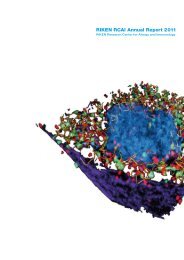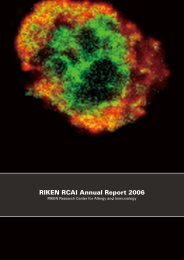in vivo
in vivo
in vivo
Create successful ePaper yourself
Turn your PDF publications into a flip-book with our unique Google optimized e-Paper software.
Sh<strong>in</strong>-ichiro Fujii<br />
On the road to a vacc<strong>in</strong>e<br />
aga<strong>in</strong>st tumors<br />
Researchers f<strong>in</strong>d how to generate an immune response <strong>in</strong> mice<br />
Figure<br />
Mechanism of the mouse immune response aga<strong>in</strong>st tumors.<br />
(a) Tumor/Gal activates NKT/NK cells. (b) The activated NKT/NK cells then kill tumor cells.<br />
(c) Next, DCs engulf tumor debris and cross-present on CD1d to NKT cells, which matures the DCs.<br />
(d) Mature antigen-captur<strong>in</strong>g DCs <strong>in</strong>duce long-lived, adaptive T-cell immunity. Reproduced<br />
from Fujii, S. et al. Immunological Reviews 220, 183–198 (2007). Copyright (2007) with<br />
permission from Blackwell Munksgaard<br />
research team from RIKEN’s Research<br />
A Center for Allergy and Immunology<br />
(RCAI) <strong>in</strong> Yokohama has discovered a means<br />
of <strong>in</strong>duc<strong>in</strong>g persistent immunity to tumors <strong>in</strong><br />
mice. In the long term, the work could lead to<br />
a vacc<strong>in</strong>e aga<strong>in</strong>st certa<strong>in</strong> tumors <strong>in</strong> people.<br />
Unlike <strong>in</strong>fectious organisms and foreign<br />
tissue, tumor cells do not elicit a powerful<br />
immune response naturally. In particular,<br />
tumors do not activate the production of<br />
immune CD4 + and CD8 + T-cells geared to<br />
fight<strong>in</strong>g them. This typically needs two signals.<br />
In addition to a compound known as<br />
an antigen which is specific to the tumor and<br />
reacts with a T-cell receptor when presented<br />
by dendritic cells (DCs), it also requires a costimulatory<br />
molecule that tumors appear to<br />
lack.<br />
In a recent paper <strong>in</strong> the Journal of<br />
Experimental Medic<strong>in</strong>e, the research team—<br />
compris<strong>in</strong>g members from RCAI and The<br />
Rockefeller University <strong>in</strong> New York—detailed<br />
a method for <strong>in</strong>duc<strong>in</strong>g immunity <strong>in</strong> mice<br />
to four common tumors last<strong>in</strong>g up to 12<br />
months.<br />
A glycolipid compound derived from mar<strong>in</strong>e sponges known as α-galactosylceramide (α-GalCer) can<br />
activate the immune system’s natural killer (NK) and natural killer T-(NKT) cells aga<strong>in</strong>st tumors, but alone<br />
does not protect mice from cancers such as B16 melanoma. The researchers found, however, that a low<br />
dose of B16 tumor cells loaded with α-GalCer and <strong>in</strong>jected <strong>in</strong>travenously will <strong>in</strong>duce a protective immune<br />
response to B16 melanoma. The same was true for three other mouse tumors which normally generated a<br />
poor immune response.<br />
To trace what was tak<strong>in</strong>g place, the team tracked labeled α-GalCer-loaded tumor cells under the confocal<br />
microscope. They found that α-GalCer did <strong>in</strong>deed activate<br />
NK and NKT cells to kill tumor cells (Figure a, b). Debris from<br />
the dead cells was captured by DCs <strong>in</strong> the spleen. These DCs<br />
then changed or matured to mount an immune response by<br />
present<strong>in</strong>g tumor antigen peptide <strong>in</strong> such a way as to stimulate<br />
the production CD4 + and CD8 + T-cells aga<strong>in</strong>st that particular<br />
tumor (cross-presentation 1) (Figure c). In addition, the mature<br />
DCs presented the orig<strong>in</strong>al α-GalCer to NKT cells aga<strong>in</strong>,<br />
stimulat<strong>in</strong>g further response (cross-presentation 2) (Figure d).<br />
Immunity aga<strong>in</strong>st <strong>in</strong>dividual tumors persisted for at least six<br />
months.<br />
“We now have a mouse model for generat<strong>in</strong>g an immune<br />
response to tumors,” says project coord<strong>in</strong>ator Sh<strong>in</strong>-ichiro Fujii.<br />
“We can use it to focus on questions of basic science, such as<br />
what triggers the immunity. We would also like to extend the<br />
research <strong>in</strong>to human patients.”<br />
ORIGINAL RESEARCH PAPER<br />
Kanako Shimizu<br />
Shimizu, K., Kurosawa, Y., Taniguchi, M., Ste<strong>in</strong>man, R.M. & Fujii, S. Cross-presentation of glycolipid from tumor<br />
cells loaded with α-galactosylceramide leads to potent and long-lived T cell-mediated immunity via dendritic<br />
cells. Journal of Experimental Medic<strong>in</strong>e 204, 2641–2653 (2007).<br />
16<br />
This article is abstracted from RIKEN RESEARCH with permission<br />
http://www.rikenresearch.riken.jp/research/381/





